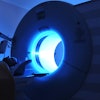ATLANTA - Radiation dose from CT heart scans can be reduced with a good scanning protocol, but radiation dose itself can vary greatly based on patient demographics, according to two studies presented at the 2006 American College of Cardiology (ACC) annual meeting.
"Most cardiologists have a perception that radiation dose from CT is high, but little quantitative data is available," said one study's lead author, Dr. Andrew Einstein, a fellow in cardiology at the Mount Sinai Medical Center in New York City.
Einstein and colleagues examined the radiation dose and lifetime attributable risks of cancer in 50 consecutive patients who underwent 16-slice coronary CT angiography (CTA). The researchers used National Academy of Sciences/International Commission on Radiological Protection's BEIR VII standards for radiation risk scoring and Monte Carlo simulations to determine the dose.
Calcium scoring was conducted if requested by the referring physician, or at the performing doctor's discretion.
The mean effective radiation dose was 2.8 mSv for calcium scoring, 9.3 mSv for complete coronary CTA, and 11.5 mSv together. Calcium scoring increased the radiation dose by 30%, while ECG pulsing decreased it by about 33%.
Comparatively, a technetium-99m sestamibi nuclear perfusion test gives a dose of 9.7 mSv, and a technetium-99m tetrofosmin study gives a dose of 8.5 mSv. Einstein said a 64-slice scanner increases the effective dose by about 50%.
In the study, radiation dose was significantly higher for females compared to males and tended to be higher for older patients as well. The highest dose was to the lungs, breast, and esophagus.
The lifetime attributable odds of cancer from a single coronary CTA study were 1:1,600 for incidence of cancer and 1:1,900 for cancer mortality. This risk was highest for younger patients and especially women.
In the second study presented at the ACC this week, German researchers were able to reduce the radiation dose from 64-slice CT angiography without sacrificing image quality by changing the scan protocol.
"I think it's a good compromise because the savings were quite substantial," said presenter Dr. Martin Hadamitzky, a cardiologist at the German Heart Center in Munich.
The researchers retrospectively examined records from 180 patients who underwent 64-slice CT angiography under different scan protocols. Radiation dose was estimated using the dose-length-product method, and image quality evaluated according to image noise. Variables between groups were well matched.
The effective dose was highest at about 15 mSv using the standard 120 kV tube current, 0.2 pitch, and no pulsing. ECG-dependent pulsing reduced the effective dose to about 10 mSv while increasing the pitch to 0.25, though pulsing added little additional benefit.
Lowering the scanner's tube current to 120 kV along with the other measures reduced the effective dose to about 7 mSv. However, image noise increased significantly when pitch increased and current decreased.
"The ECG-dependent dose pulsing significantly reduces dose estimates by approximately 37% without loss of image quality," Hadamitzky said.
By Crystal Phend
AuntMinnie.com contributing writer
March 17, 2006
Related Reading
Step-and-shoot acquisition cuts CTA dose, improves images, January 16, 2006
Heart rate determines best CTA reconstruction interval, January 2, 2006
Coronary CTA requires dedication, 64-slice minimum, November 30, 2005
64 CT slices beat 16 for stenosis and diagnosis of heart disease, November 27, 2005
Cardiac CT strategies cut dose, keep image quality, November 25, 2005
Copyright © 2006 AuntMinnie.com



















